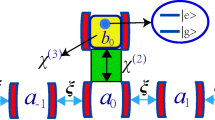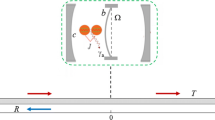Abstract
In this paper, we propose an effective model to describe the interactions between a two-level atom and scattered light in a 1-D dielectric waveguide. The proposed formalism allows us to incorporate the effect of changing optical media inside the continuum while demonstrating a non-classical derivation of Fresnel Law. We obtain the transport characteristics of the two-level system, explore its high-Q bandreject filter property and discuss the implications of radiative and non-radiative dissipation. In addition, we apply our formalism to a modified Fabry–Pérot interferometer and show the variation in its spontaneous emission characteristics with changing interferometer length. Finally, we conclude with further remarks on the link between the waveguide and cavity quantum electrodynamics.







Similar content being viewed by others
Notes
In this article, operators will be expressed using hats (such as \(\hat{f}\)) and unit-vectors will be expressed using the inverse-hats (such as \(\check{k}\)). This representation is adapted from Dr. Austin J Hedeman’s course notes at University of California Berkeley.
A more detailed discussion for the derivation of the Hamiltonian can be found in Chapter 7 of Dutra (2005).
It is important to note that in this calculation, we neglect the contribution from some interference terms which are not individually zero. Hence, our result remains as an approximation in the region where the contribution from these interference terms can be neglected, i.e. \(\frac{|n_1-n_2|}{n_1+n_2}<< 1\).
This representation of the interaction Hamiltonian differs from (1) in the two following ways: The field operators \(\phi (x)\) are replaced with \(\phi ^{(n)}(x)\) and the group velocity \(v_g\) of the photons is replaced with \(v_g/n\) to incorporate the effect of dielectric medium, \(v_g\) corresponding to the group velocity in vacuum.
We note that this is just an order approximation. A more accurate result can be obtained numerically for a given parameter set. Especially for the boundary cases, where \(\varGamma =n\varGamma _n\) and \(\varGamma = \varGamma _n /n\), this result proves to be quite accurate.
References
Bermel, P., Rodriguez, A., Johnson, S.G., Joannopoulos, J.D., Soljacic, M.: Single-photon all-optical switching using waveguide-cavity quantum electrodynamics. Phys. Rev. A 74, 043818 (2006). https://doi.org/10.1103/PhysRevA.74.043818
Birnbaum, K.M., Boca, A., Miller, R., Boozer, A.D., Northup, T.E., Kimble, H.J.: Photon blockade in an optical cavity with one trapped atom. Nature 436(7047), 87–90 (2005). https://doi.org/10.1038/nature03804
Cheng, M.-T., Ma, X.-S., Zhang, J.-Y., Wang, B.: Single photon transport in two waveguides chirally coupled by a quantum emitter. Opt. Express 24(17), 19988–19993 (2016). https://doi.org/10.1364/OE.24.019988
Deutsch, I.H., Spreeuw, R.J.C., Rolston, S.L., Phillips, W.D.: Photonic band gaps in optical lattices. Phys. Rev. A 52, 1394–1410 (1995). https://doi.org/10.1103/PhysRevA.52.1394
Dicke, R.H.: Coherence in spontaneous radiation processes. Phys. Rev. 93, 99–110 (1954). https://doi.org/10.1103/PhysRev.93.99
Dinç, F., Ercan, I.: Quantum mechanical treatment of two-level atoms coupled to continuum with an ultraviolet cutoff. J. Phys. A: Math. Theor. 51(35), 355301 (2018). https://doi.org/10.1088/1751-8121/aad165
Dutra, S.M.: Cavity Quantum Electrodynamics: The Strange Theory of Light in a Box. Wiley, New York (2005)
Fan, S., Kocabas, S.E., Shen, J.-T.: Input-output formalism for few-photon transport in one-dimensional nanophotonic waveguides coupled to a qubit. Phys. Rev. A 82, 063821 (2010). https://doi.org/10.1103/PhysRevA.82.063821
Glauber, R.J., Lewenstein, M.: Quantum optics of dielectric media. Phys. Rev. A 43, 467–491 (1991). https://doi.org/10.1103/PhysRevA.43.467
Griffiths, D.J.: Introduction to Electrodynamics. Prentice Hall, Upper Saddle River (1962)
Hacker, B., Welte, S., Rempe, G., Ritter, S.: A photonphoton quantum gate based on a single atom in an optical resonator. Nature 536(7615), 193–196 (2016). https://doi.org/10.1038/nature18592
Kittel, C., McEuen, P.: Introduction to Solid State Physics. Wiley, New York (2015)
Loudon, R.: The Quantum Theory of Light. Oxford University Press, Oxford (2010)
Mu-Tian, C., Meng-Ting, D., Yan-Yan, S., Ya-Qin, L.: Single-photon transmission characteristics in a pair of coupled-resonator waveguides linked by a nanocavity containing a quantum emitter. Chin. Phys. Lett. 30(5), 054202 (2013). http://stacks.iop.org/0256-307X/30/i=5/a=054202
Rephaeli, E., Fan, S.: Dissipation in few-photon waveguide transport. Photon. Res. 1(3), 110–114 (2013). https://doi.org/10.1364/PRJ.1.000110. http://www.osapublishing.org/prj/abstract.cfm?URI=prj-1-3-110
Rephaeli, E., Shen, J.-T., Fan, S.: Full inversion of a two-level atom with a single-photon pulse in one-dimensional geometries. Phys. Rev. A 82, 033804 (2010). https://doi.org/10.1103/PhysRevA.82.033804
Rephaeli, E., Kocabas, S.E., Fan, S.: Few-photon transport in a waveguide coupled to a pair of colocated two-level atoms. Phys. Rev. A 84, 063832 (2011). https://doi.org/10.1103/PhysRevA.84.063832
Schwartz, M.D.: Quantum field Theory and the Standard Model. Cambridge University Press, Cambridge (2014)
Shapiro, J.H.: Single-photon Kerr nonlinearities do not help quantum computation. Phys. Rev. A 73, 062305 (2006). https://doi.org/10.1103/PhysRevA.73.062305
Shen, J.T., Fan, S.: Coherent photon transport from spontaneous emission in one-dimensional waveguides. Opt. Lett. 30(15), 2001–2003 (2005). https://doi.org/10.1364/OL.30.002001. http://ol.osa.org/abstract.cfm?URI=ol-30-15-2001
Shen, J.-T., Fan, S.: Strongly correlated multiparticle transport in one dimension through a quantum impurity. Phys. Rev. A 76, 062709 (2007a). https://doi.org/10.1103/PhysRevA.76.062709
Shen, J.-T., Fan, S.: Strongly correlated two-photon transport in a one-dimensional waveguide coupled to a two-level system. Phys. Rev. Lett. 98, 153003 (2007b). https://doi.org/10.1103/PhysRevLett.98.153003
Shen, J.-T., Fan, S.: Theory of single-photon transport in a single-mode waveguide. I. Coupling to a cavity containing a two-level atom. Phys. Rev. A 79, 023837 (2009). https://doi.org/10.1103/PhysRevA.79.023837
Shi, T., Fan, S., Sun, C.P.: Two-photon transport in a waveguide coupled to a cavity in a two-level system. Phys. Rev. A 84, 063803 (2011). https://doi.org/10.1103/PhysRevA.84.063803
Tiecke, T.G., Thompson, J.D., de Leon, N.P., Liu, L.R., Vuletic, V., Lukin, M.D.: Nanophotonic quantum phase switch with a single atom. Nat. Res. Lett. 508, 241–244 (2014). https://doi.org/10.1038/nature13188
Tsoi, T.S., Law, C.K.: Quantum interference effects of a single photon interacting with an atomic chain inside a one-dimensional waveguide. Phys. Rev. A 78, 063832 (2008). https://doi.org/10.1103/PhysRevA.78.063832
Yan, C., Wei, L.: Single photon transport along a one-dimensional waveguide with a side manipulated cavity QED system. Opt. Express 23(8), 10374–10384 (2015). https://doi.org/10.1364/OE.23.010374
Zang, X., Jiang, C.: Single-photon transport properties in a waveguidecavity system. J. Phys. B At. Mol. Opt. Phys. 43(6), 065505 (2010). http://stacks.iop.org/0953-4075/43/i=6/a=065505
Acknowledgements
The authors would like thank Professor Ataç İmamoğlu for intellectually stimulating discussions, Professor Teoman Turgut for insightful comments on the manuscript and Professor Şükrü Ekin Kocabaş for inspiration and guidance on the modified Fabry–Pérot interferometer study.
Author information
Authors and Affiliations
Corresponding author
Appendices
Appendix 1: Proof of concept
A scattering eigenstate \(\mathinner {\left| {E_k}\right\rangle }\), for the Hamiltonian in (1), is given by the equation:
where we denote \(e_k\) as the probability amplitude for the excitation of the atom, and \(u_R(x)\) and \(u_L(x)\) are the complex amplitudes of the right and left moving photons, respectively.
For a photon incident far form the left, \(u_R(x)\) and \(u_L(x)\) are defined as follows
where r and t are the reflection and transmission coefficients, respectively. It is important to note that, by ansatz, the Fourier coefficient \(\bar{u}_R(k^{\prime })\) (\(\bar{u}_L(k^{\prime })\)) is zero for any \(k^{\prime }<-k\) (\(k^{\prime }>k\)) to divide strictly right-moving and left-moving part of the eigenstate. It is also important to note that the modulations in \(u_R(x)\) and \(u_L(x)\) happen between \(0^-\) and \(0^+\) due to the delta-scattering potential \(V \delta (x)\).
Solving the eigenvalue equation \(\hat{H} \mathinner {\left| {E_k}\right\rangle }=E_k \mathinner {\left| {E_k}\right\rangle }\) and applying the slowly varying field approximation, one obtains the set of equations
We can solve them to obtain
where the phase shift is given by \(b= \arctan \left( \frac{V^{\prime 2}}{ v_g(\varOmega -E_k)} \right)\), which allows us to redrive the findings of Shen and Fan (2005), Tsoi and Law (2008) using our formalism.
Appendix 2: Sanity checks for the final result
In this appendix, two sanity checks will be performed to show the consistency of (11). The first check is for the case when there is no dielectric material present. For this case, (11) becomes
where the phase shit is \(b=\arctan \{ V^2/[v_g(\varOmega -E_k)]\}\), hence resulting in the (31).
The final sanity check is regarding the conservation of probability current, or classically energy. Since there is no non-radiative decay taken into account in these calculations, the sum of transmission and reflection amplitudes is conserved such that
Note that this can be used as evidence for conservation of energy.
Rights and permissions
About this article
Cite this article
Dinç, F., Ercan, İ. Single photon two-level atom interactions in 1-D dielectric waveguide: quantum mechanical formalism and applications. Opt Quant Electron 50, 390 (2018). https://doi.org/10.1007/s11082-018-1658-y
Received:
Accepted:
Published:
DOI: https://doi.org/10.1007/s11082-018-1658-y




